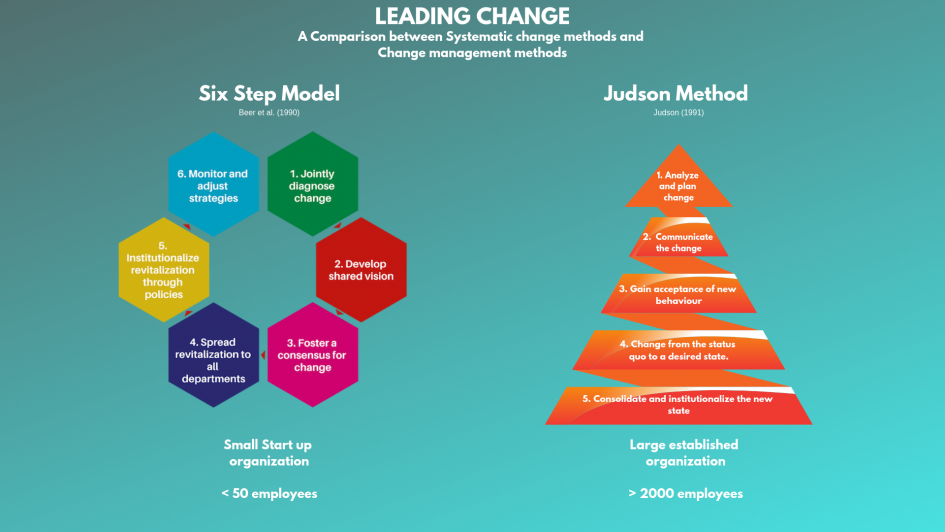When consulting two colleagues regarding successful change management, it became evident that while both may not have intentionally used specific change models, it was quite easy to pick out particular models that aligned with the information shared. Al-Haddad and Kotnour (2015) provide many examples of change methods, two of which quite clearly aligned with my colleague’s organizational changes.
When planning for these interviews, It was important to me that I pick two very different contexts. I wanted to see if different situations would call for different models and methods. The first leader I interviewed worked at a relatively small startup company. The company had been in business for four years and had experienced rapid growth. The second company was a large established organization that had been in business for close to 60 years. Both organizations were experiencing growth or advancements that required changes. Both leaders shared sentiments that were similar to what Castelli supports (2016), “leaders have become overwhelmed by the increased demand of globalization and are struggling because ‘business as usual’ is no longer effective” (p.217). If both organizations were to continue to grow and expand in their respective industries both needed to implement a change.
The startup found itself using more of a systematic change method. As the company began to implement the new systems, some small incremental changes and transitions were monitored closely by the CEO himself. As the image above suggests, it was a more cyclical process than a top-down model. Al-Haddad and Kotnour (2015) suggest, “More recent change methods have become more systematic, cyclical and integrative, involving higher levels of organizational change” (p.245). The CEO of the startup found it was important to involve the whole team in the process as he felt that his employees could offer valuable feedback and make the changes necessary for success much quicker. The CEO credits this approach as to why the change was a success within the organization. As Castelli states, “Followers admire leaders who practice transparency, engage in active listening and have an open door policy” (p.222). The startup company found that Beers et al. ‘s six-step method was effective as Al-Hadded and Kotnour (2015) surmise that the six-step method is “best implemented in small departments and units where tasks are easily determined and can be modified to affect the overall corporate performance” (p.247).
The larger organization took on a change management method where the methods are broader in scope and are designed to deal with change on a larger scale (Al-Haddad and Kotnour, 2015, p.248). An analysis determined that the model of change used by the larger organization aligned with the Judson method. It was recognized by the upper management and stakeholders of the organization that for continued growth some necessary changes needed to be implemented. Once a solution was determined, the process was shared with the entire organization. While there was resistance initially, the amendments were slowly adopted by all departments as the new systems became policies integrated into the overall mission of the organization.
It is interesting that when both models are compared side by side, the steps are very similar, however, the experiences from the leaders of the organizations were very different and determined how I chose to share them visually. On a smaller scale, such as the startup, the leadership when implementing change can involve the employees in the process. It may be easier to get a team to buy into a vision when they were involved from the early beginnings of the initiative. It can be argued that the larger a company becomes it may be necessary to mandate changes as it would not be feasible to involve every employee in the decision-making process. Regardless of the size of the organization; however, changes can and are often are made successfully within the context of both small and large companies. If the process of change is part of its culture, then size becomes a non-sequitur issue as Khan (2017) succinctly states, “leading with a plan for dealing with change, then, is a requirement” (p.179).
As Heraclitus stated, “the only constant is change”. When it comes to change management there is no one size fits all model. With proper planning and the fostering of a culture of continued growth, most organizations will be able to navigate the tricky waters of change and come out the other side stronger from the journey.
References
Al-Haddad, S., & Kotnour, T. (2015). Integrating the organizational change literature: a model for successful change. Journal of Organizational Change Management, 28(2), 234-262.
Castelli, P. (2016). Reflective leadership review: a framework for improving organisational performance. Journal of Management Development, 35(2), 217-236.
Khan, N. (2017). Adaptive or Transactional Leadership in Current Higher Education: A Brief Comparison. The International Review of Research in Open and Distributed Learning, 18(3).


Leave a Reply